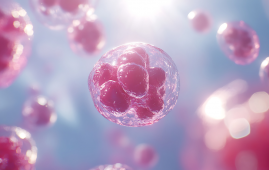

There is a protein that governs everything from humans to plants to single-cell creatures. This protein performs general cell housekeeping, controlling them through routine daily tasks. Researchers at Virginia Tech discovered that one specific type of this ubiquitous protein has a different purpose in female brains—it helps regulate memory events that produce post-traumatic stress disorder (PTSD).
“The protein is primarily thought of as a protein that marks other proteins to be destroyed,” said Tim Jarome, an associate professor in the College of Agriculture and Life Sciences’ School of Animal Sciences. “For it to be doing this function in the context of PTSD in females is very surprising.”
Because of its widespread prevalence, this protein, ubiquitin, even has its name derived from the word ubiquitous. The researchers were able to modify a variant of this protein called K-63, which was selective in creating fear memories in the female brain.
“Oftentimes, molecules are found in the brain that are involved in forming these fear-based memories in both sexes, and this is the first time that we found one that’s selectively involved in one sex,” Jarome said. “In particular, this was found in the sex that seems to be more likely to have PTSD. It’s rare to find these mechanisms that are specific to one sex in terms of regulating the underlying factors that cause PTSD.”
The breakthrough could pave the way for better therapeutic treatments. The experiment was led by Kayla Farrell, a Ph.D. candidate in the School of Animal Sciences.
The findings were recently published in the journal Molecular Psychiatry.
PTSD is a complex illness with numerous therapeutic options, including pharmaceutical methods. Pharmacological treatments could be employed if a specific molecule is targeted.
“Right now, treatment options are not very effective and the success rate isn’t very good,” Jarome said. “PTSD is not created equal among patients, and we know females are more likely to have it. The therapeutic approaches that we take to treat it might have to differ between males and females. This may be a mechanism in which we could specifically target treatment in females as a way to treat PTSD.”
more recommended stories
 How Soybean Oil Impacts Weight Gain and Metabolism
How Soybean Oil Impacts Weight Gain and MetabolismWhy Soybean Oil May Affect Metabolism.
 Coffee and Cognitive Function: Evidence Review
Coffee and Cognitive Function: Evidence ReviewA new narrative review in Cureus.
 Colorectal Cancer Screening Rates Low in Adults 45–49
Colorectal Cancer Screening Rates Low in Adults 45–49Recent UCLA research reveals that colorectal.
 Gut Immune Cells and Long-Lasting Antiviral Protection.
Gut Immune Cells and Long-Lasting Antiviral Protection.Breakthrough Findings on How Gut Immune.
 Mild Pancreatic Duct Dilatation Signals Higher Cancer Risk
Mild Pancreatic Duct Dilatation Signals Higher Cancer RiskEarly Structural Changes Offer Critical Clues.
 How the Uterus Senses Force During Labor: New Insights
How the Uterus Senses Force During Labor: New InsightsA new study published in Science.
 Fat-Free Mass and Brain Outcomes in Preterm Babies
Fat-Free Mass and Brain Outcomes in Preterm BabiesEarly Fat-Free Mass May Hold the.
 How Hormones Shape Dopamine-Driven Learning
How Hormones Shape Dopamine-Driven LearningNYU Study on Hormones and Cognitive.
 Protein Pair Guides Chromosome Alignment in Mitosis
Protein Pair Guides Chromosome Alignment in MitosisKey Points A joint research team.
 Intensive mind-body retreat rapidly alters brain function
Intensive mind-body retreat rapidly alters brain functionAn intensive mind-body retreat combining meditation,.

Leave a Comment